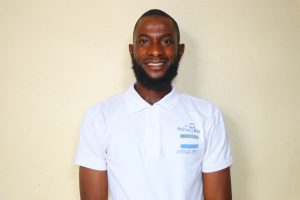The 224 residents of the Rowullah Community walk an arduous distance to a swamp to collect water, a journey that steals their time and health.

The swamp.
"The water users are suffering to access clean, safe drinking water in the community. They walk a long distance to access water, and this water is not safe to drink. They are exposed to snake bites. Walking a long distance together with the water users to access this swamp water is not easy. They have no option but to access these sources to remedy the water crisis in the community," shared Field Officer Alie Kamara.
"This water's appearance looks clean, but there is brown sludge floating on the water, and this makes the color of the water change. This makes the taste [and] smell of this water differ," Alie continued.
Their community has an old well, but it ran dry years ago. Left with no other options, they go to the swamp to collect the water they need.

The community well has run dry.
10-year-old Adamsay feels the pain of her long journey for water every day.
"The water source is far from my house, so I walk a long distance to access water every day. This takes me so long to reach and return home."

Adamsay collecting swamp water.
"I do feel bad when sent to fetch water. The distance to the water source is far, and I am afraid of snake bites in the bush," she continued.
Adamsay spends so much time walking to the swamp and collecting water that she often sacrifices her education. Every moment in the classroom is crucial, and as a young girl, attaining an education is already an uphill battle. Her community's water crisis means her opportunity to get an education gets smaller and smaller.
"Fetching water impacts my time at school, which prevents me from getting good grades. Sometimes, I am late to go to school, and they [punish] me. Every day, I go to school, and I miss out on lessons, and when exam time comes, I do not get good grades."

Adamsay.
Rehabilitating the well that is already in their community and close to their homes will give Adamsay the opportunity to enjoy her childhood and pursue her education fully. She won't have to travel to the swamp, fear for her safety, and feel the weight of the heavy water container. With clean, safe water within her reach, Adamsay can dream big!
Steps Toward a Solution
Our technical experts worked with the local community to identify the most effective solution to their water crisis. They decided to drill a borehole well, construct a platform for the well, and attach a hand pump.
Well
Abundant water often lies just beneath our feet. Aquifers—natural underground rivers—flow through layers of sediment and rock, offering a constant supply of safe water. A borehole well is drilled deep into the earth to access this naturally filtered and protected water. We penetrate meters, sometimes even hundreds of meters, of soil, silt, rock, and more to reach the water underground. Once found, we construct a platform for the well and attach a hand pump. The community gains a safe, enclosed water source capable of providing approximately five gallons of water per minute. Learn more here!
Community Education & Ownership
Hygiene and sanitation training are integral to our water projects. Training is tailored to each community's specific needs and includes key topics such as proper water handling, improved hygiene practices, disease transmission prevention, and care of the new water point. Safe water and improved hygiene habits foster a healthier future for everyone in the community. Encouraged and supported by the guidance of our team, a water user committee representative of the community's diverse members assumes responsibility for maintaining the water point, often gathering fees to ensure its upkeep.

 Borehole Well and Hand Pump
Borehole Well and Hand Pump

















